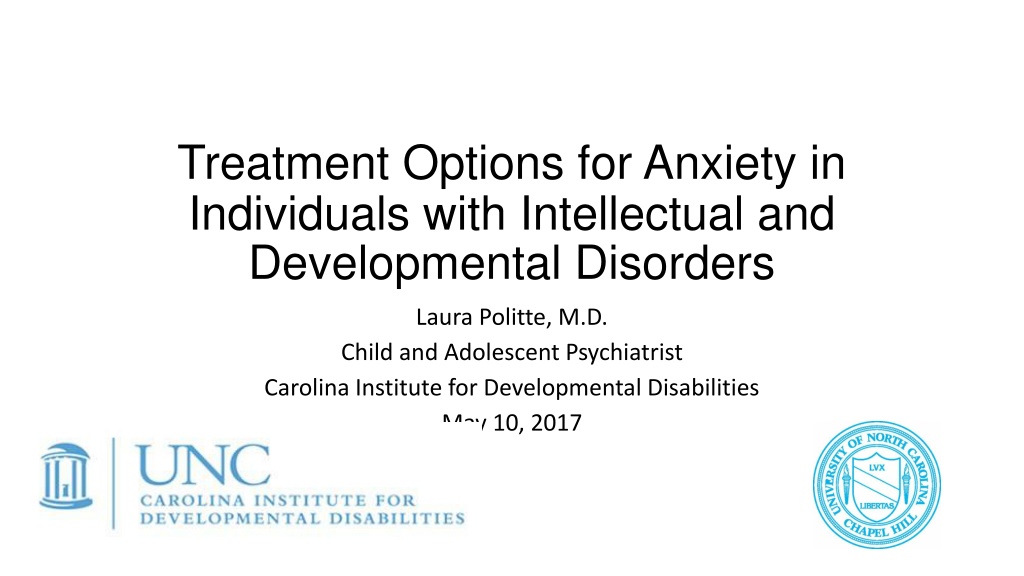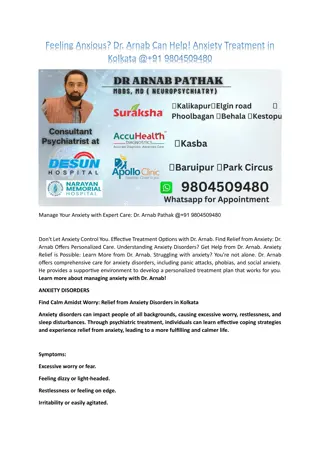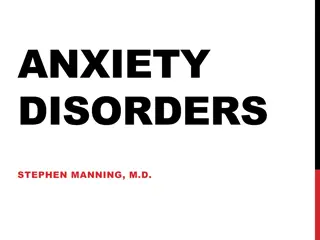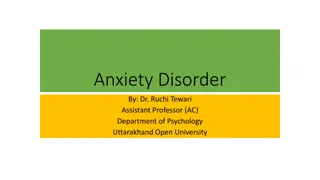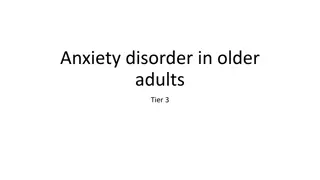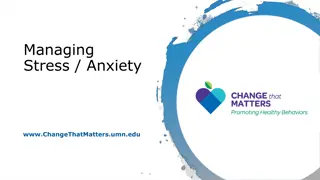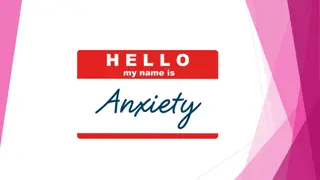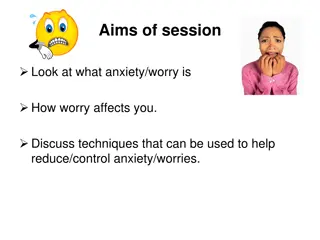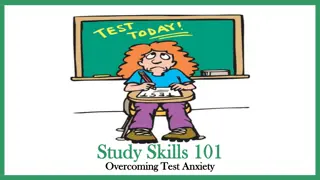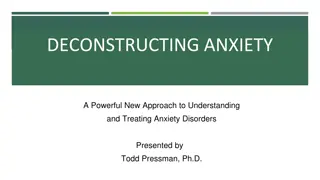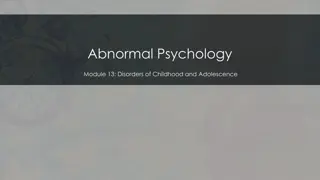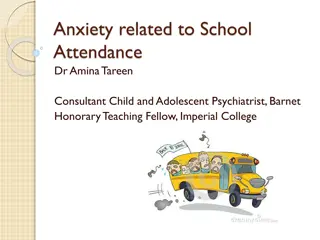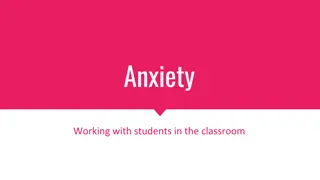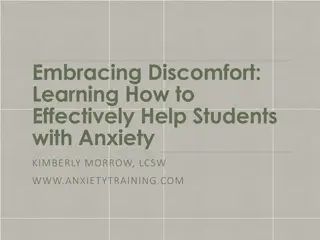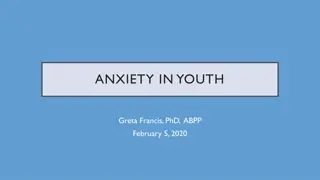Treatment Options for Anxiety in Individuals with Intellectual and Developmental Disorders
Explore unique presentations of anxiety in individuals with intellectual and developmental disorders, evaluate evidence-based interventions - both pharmacological and non-pharmacological, review practical strategies for managing anxiety symptoms, and identify barriers to treatment and future research directions for individuals with I/DD and anxiety.
- Anxiety
- Intellectual Disorders
- Developmental Disorders
- Treatment Options
- Pharmacological Interventions
Download Presentation

Please find below an Image/Link to download the presentation.
The content on the website is provided AS IS for your information and personal use only. It may not be sold, licensed, or shared on other websites without obtaining consent from the author. Download presentation by click this link. If you encounter any issues during the download, it is possible that the publisher has removed the file from their server.
E N D
Presentation Transcript
Treatment Options for Anxiety in Individuals with Intellectual and Developmental Disorders Laura Politte, M.D. Child and Adolescent Psychiatrist Carolina Institute for Developmental Disabilities May 10, 2017
Learning Objectives Learning Objectives Identify unique presentations of anxiety in individuals with intellectual and developmental disorders (I/DD). Evaluate the evidence for pharmacological and non- pharmacological interventions for anxiety in individuals with I/DD. Review practical strategies for managing anxiety symptoms. Identify barriers to treatment and future directions for research and the care of individuals with I/DD and anxiety.
First, a caveat First, a caveat Research about treatment options in broadly defined intellectual and developmental disability (I/DD) is limited. Most of the evidence comes from studies in autism spectrum disorder (ASD). However, many of the strategies for ASD can be useful for people with other developmental disorders, too.
Anxiety: Overview and Definitions Anxiety: Overview and Definitions Anxiety: a feeling of worry, nervousness, or unease, typically about an imminent event or something with an uncertain outcome Anxiety exists on a spectrum: Useful Debilitating Anxiety disorders: typically defined by the Diagnostic and Statistical Manual, 5thEdition (DSM-5) Symptoms are frequent, severe, and cause significant distress or impairment Treatment usually warranted
When is treatment warranted? When is treatment warranted? Focus on level of individual distress and functional impairment: Interferes with developing friendships School avoidance/ refusal Disruption to family functioning Sleep disturbance Significant tantrums/ meltdowns Faltering academics Compulsive behaviors that distresses child/ interfere with daily functioning
DSM DSM- -5 Anxiety Disorders 5 Anxiety Disorders Separation Anxiety Disorder Selective Mutism Specific Phobia Social Anxiety Disorder (Obsessive Compulsive Disorder) Panic Disorder Agoraphobia Generalized Anxiety Disorder Substance-/Medication-Induced Anxiety Disorder Anxiety Disorder due to a General Medical Condition *These categories have driven most anxiety-related research and drug development.
Anxiety in ID and Genetic Syndromes Anxiety in ID and Genetic Syndromes Prevalence of anxiety is 3-22% in ID Challenge of diagnostic overshadowing Genetic syndromes with high rates of anxiety: Fragile X syndrome Social anxiety, sensory defensiveness Williams syndrome Phobias Angelman syndrome Separation anxiety, social anxiety
Anxiety in ASD Anxiety in ASD Anxiety is very common (prevalence~ 40% in ASD) May fit DSM-5 definitions or present as atypical variant 4 most frequent DSM disorders include: Specific phobias (e.g., fear of the dark, insects, needles) Generalized anxiety disorder Social anxiety disorder Obsessive Compulsive Disorder Symptoms don t always map neatly onto DSM-5 defined categories Positive association between anxiety and IQ
Anxiety in ASD: Symptom Overlap Anxiety in ASD: Symptom Overlap Extreme upset with change, deviation from routine Insistence on sameness Discomfort in social situations Aversiveness to sensory stimuli ASD Anxiety
Anxiety in ASD and ID Anxiety in ASD and ID Social skills deficits/ peer rejection Difficulty tolerating unpredictability Difficulty with change/ transitions Communication impairment Anxiety Sensory defensiveness Rigid thought patterns
Social Anxiety in ASD Social Anxiety in ASD More common in older kids with average or above-average IQ (greater social awareness). Fear of negative evaluation by peers may be a realistic concern. Distinct from avoidance of social interactions due to lack of interest. Risk factors for social anxiety Social skills deficits Elevated physiological arousal Insight into social differences Social Anxiety
ASD and OCD ASD and OCD Where do we draw the line? Fixated, restricted interests Obsessions Repetitive behavior Compulsions Distress with rituals/ compulsions may help distinguish, but not always Hoarding, compulsive ordering, and repetition may be more common in ASD
Assessment of Anxiety in ASD and ID Assessment of Anxiety in ASD and ID Initial Evaluation: Detailed history of anxiety symptoms in key areas Tolerance of change, sensory sensitivities, fears/ phobias, social anxiety, etc Rule out medical cause (pain/discomfort, hyperthyroidism, med effect) Determine cognitive/ verbal levels Are there modifiable contributing factors? Undiagnosed learning difficulties? Peer bullying? Lack of structure/ routine? Is there psychiatric comorbidity that might influence treatment? Comorbid ADHD, depression, severe irritability
Treatment of Anxiety in ASD and ID Treatment of Anxiety in ASD and ID Address specific sources of anxiety with behavioral interventions first: Sensory defensiveness: OT, noise-cancelling headphones, accommodations for overstimulating situations, weighted blanket, self-soothing strategies Difficulty tolerating the unknown/ change: Use of social stories, previewing new situations, written/ picture schedules, transitional objects, visual timers, graded exposure Social anxiety: Cognitive Behavioral Therapy (CBT), social skills building Fears/ phobias/ compulsions: CBT; exposure therapy
Non Non- -Pharmacological Interventions with Positive Pharmacological Interventions with Positive Evidence for Anxiety in ASD Evidence for Anxiety in ASD Cognitive-Behavioral Therapy Documented efficacy for both group and individual interventions Moderate effect sizes (in higher-functioning youth) Social Skills Training Especially for social anxiety May be woven into CBT
Cognitive Behavioral Therapy for ASD/ID Cognitive Behavioral Therapy for ASD/ID Core Components: Psychoeducation about anxiety (e.g., helpful vs unhelpful anxiety; cognitive, behavioral, and physiological components) Cognitive strategies (identify and challenge anxious cognitions) Behavioral strategies (graded exposure, exposure and response prevention, behavioral experiments to test anxious predictions) *In ASD, may need to adapt to capitalize on strengths, account for ASD- related deficits, and appeal to unique interests.
CBT adaptations for ASD CBT adaptations for ASD Chunking of content, alternating with down time Use of special interests unique to individual Helps to build therapeutic rapport Increases engagement and enthusiasm Offers opportunity for concrete, accessible metaphors Inclusion of social skills instruction For lower verbal/ cognitive ability: Focus is on behavioral, not cognitive interventions Increased parent involvement and manipulation of environment
ASD ASD- -Specific Treatment Protocols Specific Treatment Protocols Multimodal Anxiety and Social Skills Intervention Facing Your Fears* Behavioral Interventions for Anxiety in Children with Autism
Facing Your Fears Facing Your Fears: Example of Group Therapy : Example of Group Therapy 15 weekly, 90 min sessions with parent and child components Designed for children with high-functioning autism and social phobia, generalized anxiety disorder, separation anxiety disorder, or specific phobia CBT-based interventions, adapted for ASD *Offered locally at TEACCH Chapel Hill Center (ages 8-14)
Facing Your Fears Facing Your Fears: Essential Elements : Essential Elements Identify child s worries and associated behaviors, symptoms Understand connection between body s reaction and anxious thoughts Externalize anxiety symptoms ( worry bugs , helper bugs ) Recognition of automatic negative thoughts Learn relaxation strategies and activities, positive coping statements Create a hierarchy of anxiety-provoking situations Develop graded exposure activities based on individual hierarchy Social skills building Create and star in a Facing Your Fears video
Tips and Strategies for Home Tips and Strategies for Home For caregivers: Keep a calm, confident demeanor Validate, but don t reinforce anxious thoughts/ feelings Redirect when anxious talk becomes perseverative Provide support, but don t avoid the source of anxiety Encourage child to develop self- help strategies Reward efforts at bravery For kids: Use a visual scale to identify levels of anxious feelings and behaviors Practice self-help strategies (deep breaths, muscle relaxation, taking a break) Identify a calming space Graded exposure (with adult support)
Graded Exposure Hierarchy Example: Fear of Insects Graded Exposure Hierarchy Example: Fear of Insects Find and hold a caterpillar outside Visit a butterfly house Stand next to Dad while he holds a caterpillar Look at insects in glass containers Watch You Tube videos of spiders Imagine self holding a bug Pair exposures with relaxation strategies as needed Establish rewards for accomplishing each step
The Incredible 5 The Incredible 5- -Point Scale Point Scale (http://www.5pointscale.com/) (http://www.5pointscale.com/) Helps children recognize stages of specific challenge and identify self- calming strategies at each stage (1-5) Can be adapted to a range of emotions/ behaviors Identify in child s own words: Term to describe behavior at each level What behavior feels like to him/ her at each level What the child, teacher, parent can do to address behavior at each level
The Incredible 5 The Incredible 5- -Point Scale: Examples Point Scale: Examples
The Incredible 5 The Incredible 5- -Point Scale: Examples Point Scale: Examples
Medication Interventions for Anxiety Medication Interventions for Anxiety No published clinical drug trials specifically for anxiety in ASD Underdeveloped area of research Clinicaltrials.gov: 1 open-label buspirone trial 1 withdrawn buspirone randomized, controlled trial (RCT) 1 sertraline RCT in 2-5 year olds (anxiety is secondary outcome; primary is a cognitive measure) 1 mirtazapine RCT Multiple oxytocin trials with anxiety as secondary outcome All other trials are for CBT, social skills training, or other behavioral therapies
Why are medication trials for anxiety in ASD/ID Why are medication trials for anxiety in ASD/ID so scant? so scant? Difficulty in defining anxiety in ASD/ID Symptom overlap Limits of self-report Lack of well-established outcome measures Heterogeneity within the ASD/ID populations Lack of defined biomarkers Costly and difficult to undertake
SSRIs approved for anxiety in children without ID/D SSRIs approved for anxiety in children without ID/D Medication FDA Indication Approved Ages Duloxetine* Generalized Anxiety Disorder 7+ Fluoxetine OCD; Depression 8+ (OCD), 7+ (depression) Sertraline OCD 6+ Fluvoxamine OCD 8+ Escitalopram Depression 12+ Clomipramine OCD 10+
SSRIs in Children with ASD SSRIs in Children with ASD Despite being commonly prescribed (about 32%), evidence supporting SSRI use in ASD/IDD is limited. 1 large, negative study of citalopram for repetitive behavior Increased risk of behavioral side effects ( activation ) and insomnia 1 large, negative study and 1 smaller, positive study of fluoxetine for repetitive behavior 1 positive study of fluoxetine for repetitive behavior in adults 1 negative open-label study of fluvoxamine in children Poorly tolerated in children, but some benefit in adults *SSRIs may be more effective and better tolerated in adults than children with ASD. *No studies yet with anxiety as the primary outcome of interest.
Buspirone Buspirone Buitelaar et al (1998): Open label buspirone (15-45 mg/day) for 6-8 weeks 22 children with Autistic Disorder (N=2) or PDD-NOS (N=20), ages 6-17 Target symptoms: Anxiety = 14, Irritability = 1, Anxiety + Irritability = 7 9/22 with marked improvement, 7 with moderate improvement Well-tolerated Buitelaar JK et al. J Clin Psychiatry. 1998 Feb;59(2):56-9.
Buspirone Buspirone Chugani et al (2015): 166 children, ages 2-6, 24-week randomized, controlled trial Anxiety measures were secondary outcomes Improvement in repetitive behavior scores primary outcome Significant improvement in Anxiety Composite score for children taking 2.5 mg twice a day (p<0.001) or placebo (p=0.004), but not 5 mg twice a day (p=0.214). No significant adverse effects Chugani DC et al. J Pediatr 2016;170:45-53.
Use of Medication for Anxiety Use of Medication for Anxiety (Off-label) prescribing guidelines: Start with SSRI (fluoxetine or sertraline) at very low dose (liquid preparations can help). Follow similar monitoring guidelines as used in anxiety in children without ASD. Consider buspirone or mirtazapine as alternatives. Less likely to cause behavioral activation. Buspirone now studied in young children (2-6) Mirtazapine may also be helpful for sleep, poor appetite Use benzodiazepines only with caution. Paradoxical agitation is common.
Use of Medication for Anxiety Use of Medication for Anxiety Suggested dosing guidelines*: Fluoxetine: Prepubertal: Start 2 mg daily x2 wk, then increase by 2 mg every 2 wk up to max of 20 mg/day. Adolescents: Start 5 mg daily x2 wk, then increase by 5 mg every 2 wk up to max of 40 mg/day. Sertraline: Prepubertal: Start 5 mg daily x2 wk, then increase by 5 mg every 2 wk up to max of 100 mg/day. Adolescents: Start 12.5 mg daily x2 wk, then increase by 12.5-25 mg every 2 wk up to max of 200 mg/day. *Suggestions only, no evidence base for use in ASD/ID.
Use of Medication for Anxiety Use of Medication for Anxiety Suggested dosing guidelines*: Buspirone: Prepubertal: Start 2.5 mg daily x1 wk, then 2.5 mg twice daily x1 wk, then increase by 2.5 mg/day every 1 wk as needed/ tolerated. Max dosing 20 mg twice daily. Adolescents: Start 2.5 mg twice daily x1 wk, then 5 mg twice daily x1 wk, then increase by 2.5 mg daily weekly up to max of 20 twice daily. Increase up to 20 mg three times a day as needed. Mirtazapine: Prepubertal: Start 3.75 mg (1/4 of 15 mg tab) daily x2 wk, then increase by 3.75 mg every 2 wk as needed up to max of 45 mg/day. Adolescents: Start 7.5 mg (1/2 of 15 mg tab) daily x2 wk, then increase by 7.5 mg every 2 wk up to max of 45 mg/day. *Suggestions only, no evidence base for use in ASD/ID.
Challenges to Treatment/ Future Directions Challenges to Treatment/ Future Directions Clinicians with expertise in both ASD and anxiety are hard to find Fewer still trained in CBT Even fewer in private practice accept insurance Limited resources in rural areas Long waiting lists in well-resourced areas Lack of evidence base for medication use
Summary: Treatment of Anxiety in ASD/ ID Summary: Treatment of Anxiety in ASD/ ID Target the source of anxiety with appropriate behavioral interventions. Modify the environment as needed. CBT, social skills, behavioral therapy considered first-line. Limited evidence base for psychotropic medication. Consider cautious SSRI, buspirone, or mirtazapine trial. Consider age, side effect profile, and previous treatments when selecting agent. Start low, go slow.
Additional Resources Additional Resources TEACCH Chapel Hill, Facing Your Fears group: http://teacch.com/regional- centers/chapel-hill-teacch-center/face-your-fears-intervention-group Autism Treatment Network Blood Draw Toolkit: https://www.autismspeaks.org/science/resources-programs/autism- treatment-network/tools-you-can-use/blood-draw-toolkits The Incredible 5-Point Scale: http://www.5pointscale.com/smart_ideas.htm Autism Treatment Network Medication Decision Aid: https://www.autismspeaks.org/science/resources-programs/autism- treatment-network/tools-you-can-use/medication-guide Association for Behavioral and Cognitive Therapies (finding a CBT therapist): http://www.findcbt.org/xFAT/
